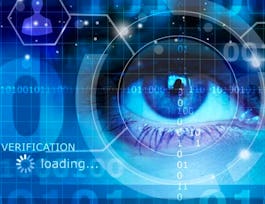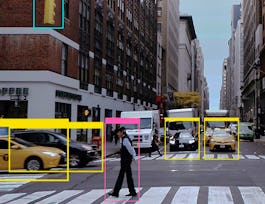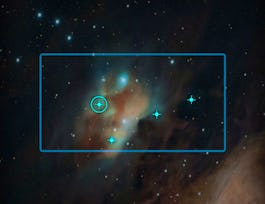By the end of this course, learners will understand what computer vision is, as well as its mission of making computers see and interpret the world as humans do, by learning core concepts of the field and receiving an introduction to human vision capabilities. They are equipped to identify some key application areas of computer vision and understand the digital imaging process. The course covers crucial elements that enable computer vision: digital signal processing, neuroscience and artificial intelligence. Topics include color, light and image formation; early, mid- and high-level vision; and mathematics essential for computer vision. Learners will be able to apply mathematical techniques to complete computer vision tasks.


Computer Vision Basics
Taught in English
Some content may not be translated
78,772 already enrolled
(1,801 reviews)
Recommended experience
What you'll learn
Understand what computer vision is and its goals
Identify some of the key application areas of computer vision
Understand the digital imaging process
Apply mathematical techniques to complete computer vision tasks
Skills you'll gain
Details to know

Add to your LinkedIn profile
9 quizzes
See how employees at top companies are mastering in-demand skills


Earn a career certificate
Add this credential to your LinkedIn profile, resume, or CV
Share it on social media and in your performance review

There are 4 modules in this course
In this module, we will discuss what computer vision is, the fields related to it, the history and key milestones of it, and some of its applications.
What's included
13 videos2 readings3 quizzes1 app item1 plugin
In this module, we will discuss color, light sources, pinhole and digital cameras, and image formation.
What's included
4 videos1 reading3 quizzes2 app items
In this module, we will discuss the three-level paradigm of computer vision that was proposed by David Marr. We will also discuss low, mid, and high level vision.
What's included
5 videos1 reading2 quizzes1 app item
In this lecture, we will discuss the Mathematics used in Computer Vision, which includes linear algebra, calculus, probability, and much more.
What's included
8 videos2 readings1 quiz1 app item
Instructors

Recommended if you're interested in Algorithms
Why people choose Coursera for their career




Learner reviews
Showing 3 of 1801
1,801 reviews
- 5 stars
55.66%
- 4 stars
23.86%
- 3 stars
10.54%
- 2 stars
4.21%
- 1 star
5.71%
New to Algorithms? Start here.

Open new doors with Coursera Plus
Unlimited access to 7,000+ world-class courses, hands-on projects, and job-ready certificate programs - all included in your subscription
Advance your career with an online degree
Earn a degree from world-class universities - 100% online
Join over 3,400 global companies that choose Coursera for Business
Upskill your employees to excel in the digital economy
Frequently asked questions
Learners should have basic programming skills and experience (understanding of for loops, if/else statements). Learners should also be familiar with the following: basic linear algebra (matrix vector operations and notation), 3D co-ordinate systems and transformations, basic calculus (derivatives and integration), basic probability (random variables), and 3D co-ordinate systems & transformations.
Access to lectures and assignments depends on your type of enrollment. If you take a course in audit mode, you will be able to see most course materials for free. To access graded assignments and to earn a Certificate, you will need to purchase the Certificate experience, during or after your audit. If you don't see the audit option:
The course may not offer an audit option. You can try a Free Trial instead, or apply for Financial Aid.
The course may offer 'Full Course, No Certificate' instead. This option lets you see all course materials, submit required assessments, and get a final grade. This also means that you will not be able to purchase a Certificate experience.
When you purchase a Certificate you get access to all course materials, including graded assignments. Upon completing the course, your electronic Certificate will be added to your Accomplishments page - from there, you can print your Certificate or add it to your LinkedIn profile. If you only want to read and view the course content, you can audit the course for free.









